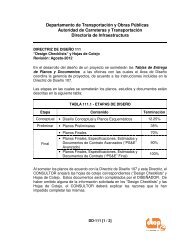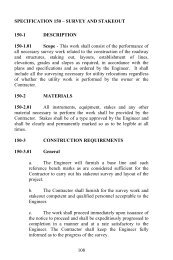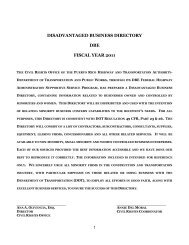DISADVANTAGED BUSINESS DIRECTORY - DTOP
DISADVANTAGED BUSINESS DIRECTORY - DTOP
DISADVANTAGED BUSINESS DIRECTORY - DTOP
Create successful ePaper yourself
Turn your PDF publications into a flip-book with our unique Google optimized e-Paper software.
The single Labour Theory of ValueAdam Smith had noticed that, when the net income or surplus is fully absorbed by wages,the price of a commodity is exactly equal to its labour-embodied value.This situation, however, only took place according to Adam Smith, ‘in that early and rudestate of society...’ (The Wealth of Nations, 5 th edition, 1789, Book I, chapter VI).Making use of the matrix notation, we can easily demonstrate the above Smiths dictum.vA + L = vB [1]v(B - A) = Lv = L(B - A) -1[1.a][1.b]The determination of the absolute value of any commodity, expressed by the row vector oflabour-embodied values (v), depends uniquely on the order n square matrix A regardingthe quantities of means of production, on the diagonal output matrix B and on the rowvector of the direct labour quantities L.However, when we try to determine the prices of production, their solution is not assimple as above. Besides the n prices, we have two additional unknowns, the distributivevariables r and w.Such price system can be expressed as follows:pA(1+r)+wL = pB [2]p = price row vector;B = diagonal output matrix;r = rate of profits (scalar);w = pb, the wage rate, where b is a column vector comprising a basket of consumptiongoods;The means of production, represented by the square matrix A, correspond to thecirculating capital, that is, they are fully consumed during the productive period. The fixedcapital, comprised of machines and equipments, used up in the course of severalproduction periods, was not included here, due to the need of a complex mathematicaltreatment. However, if we want to include the fixed capital in the above price system, itshould be treated like we did with the circulating capital, that is, it will be entirelyconsumed in one production period, that is, the depreciation rate δ = 1.The equation [2] is the Sraffa’s price system expressed in matrix notation. As it can benoticed, such system operates in a competitive economy, given a uniform rate of profits.The difference between the price system proposed by Sraffa and that proposed by Marxand other classical economists lies on the fact that the wages are paid post-factum, insteadof a wage fund.3
















